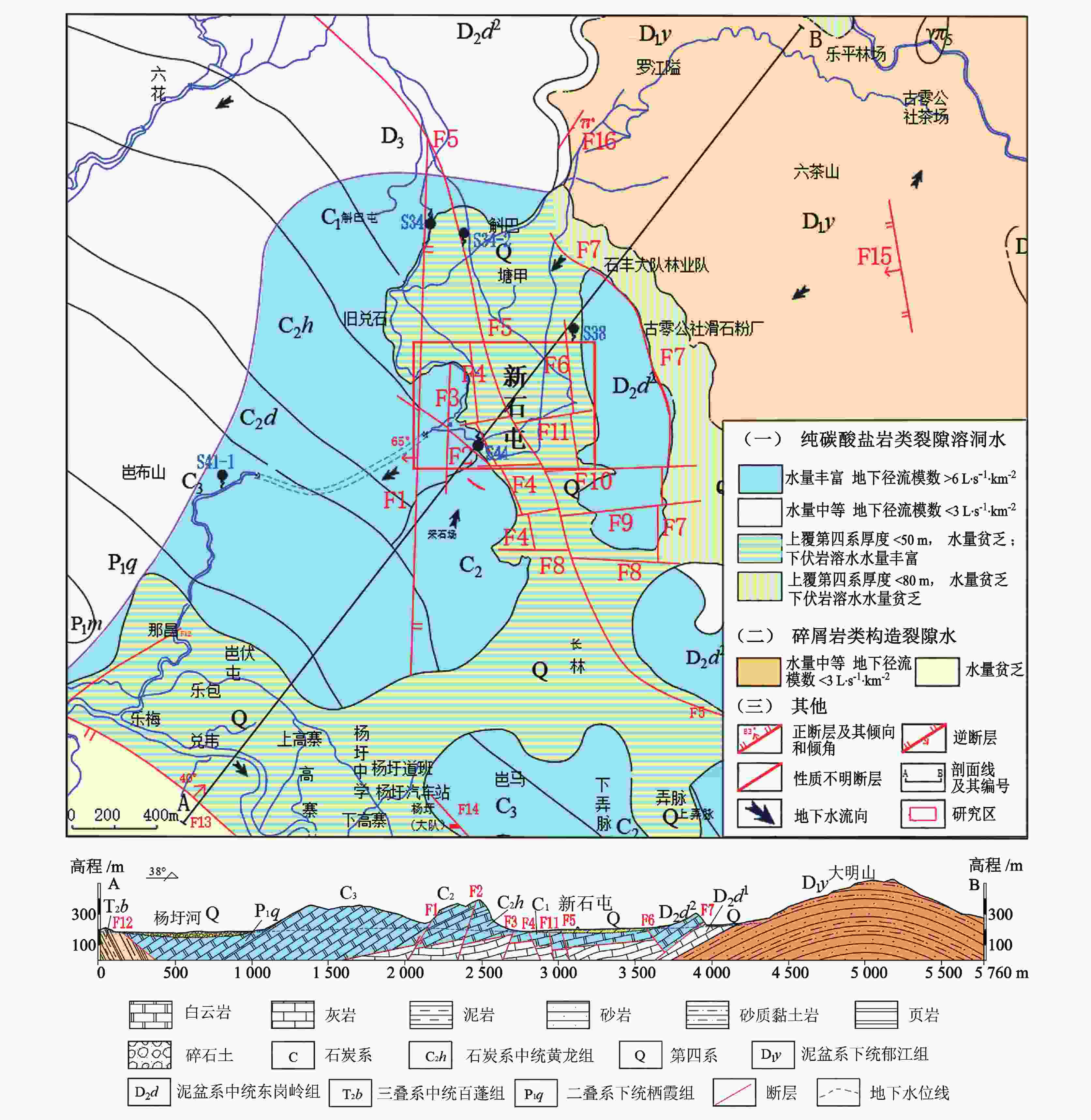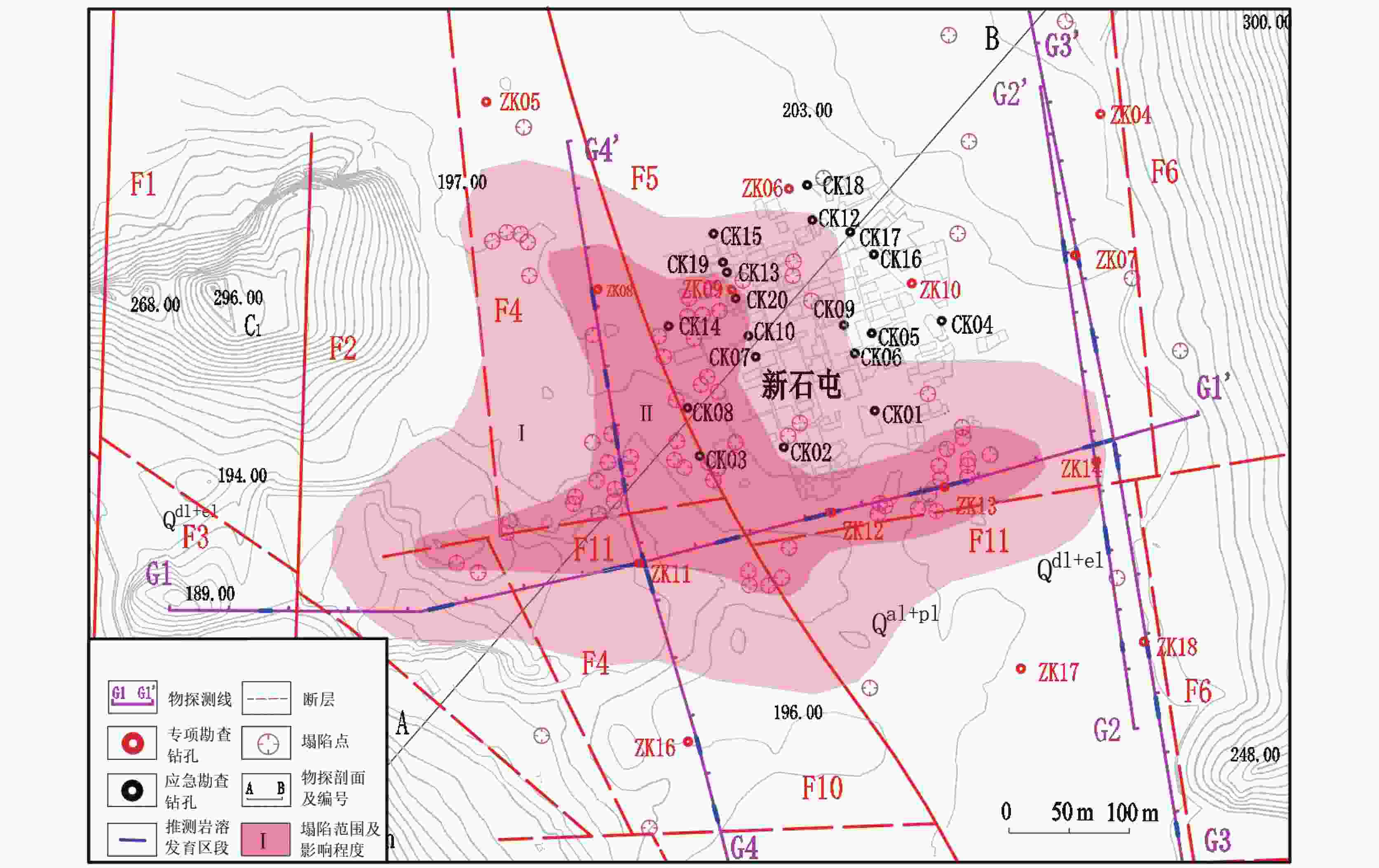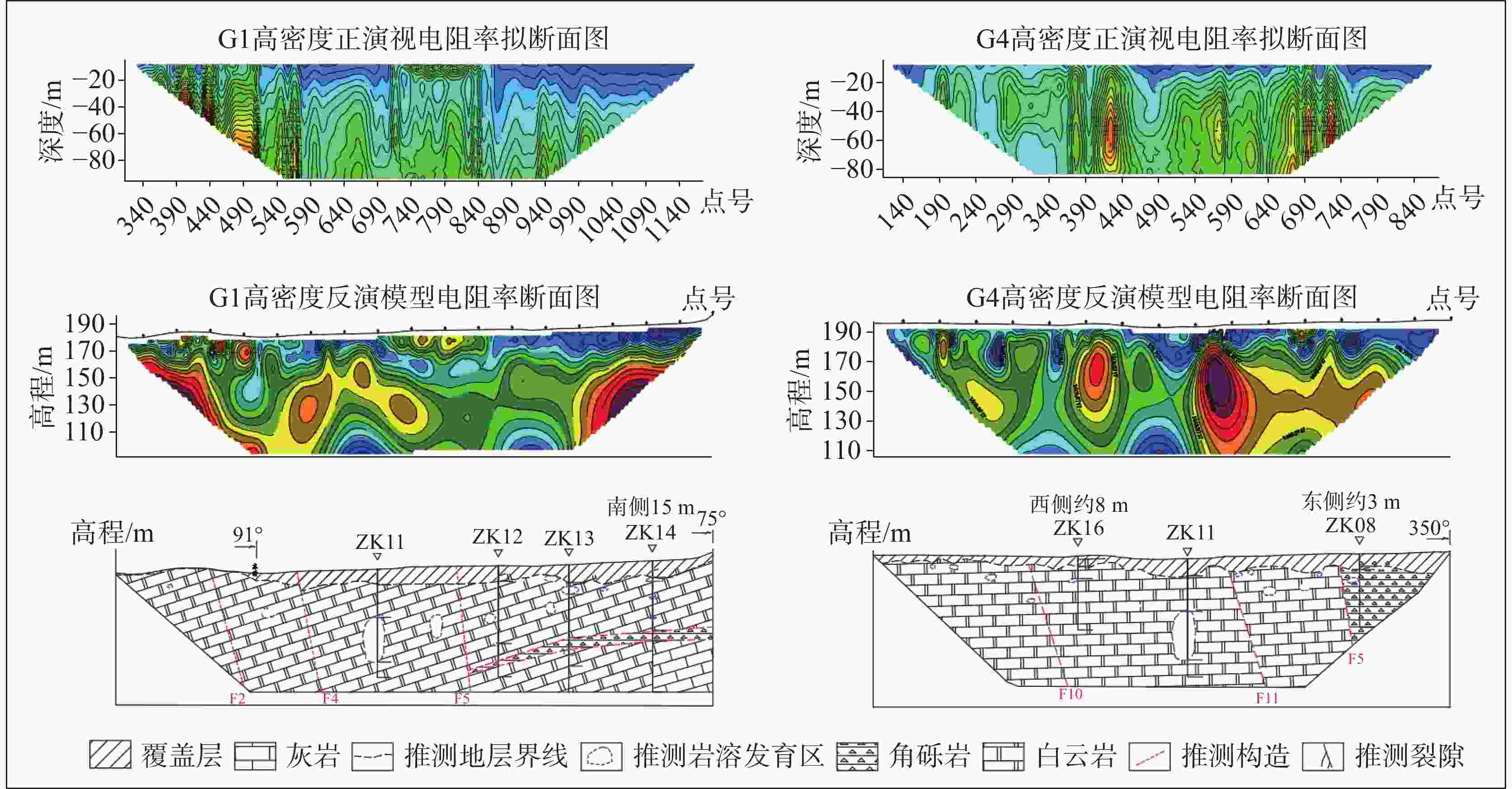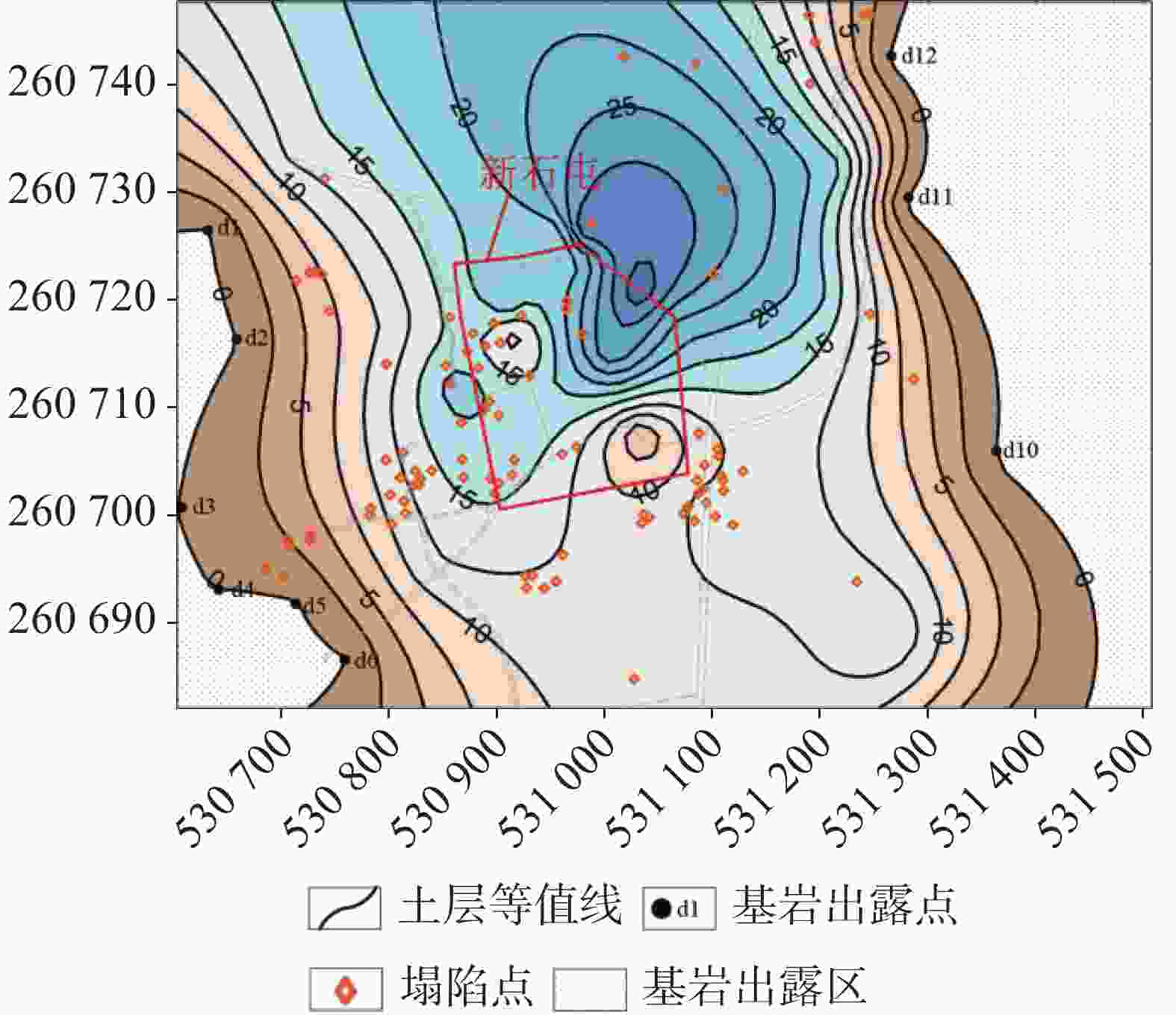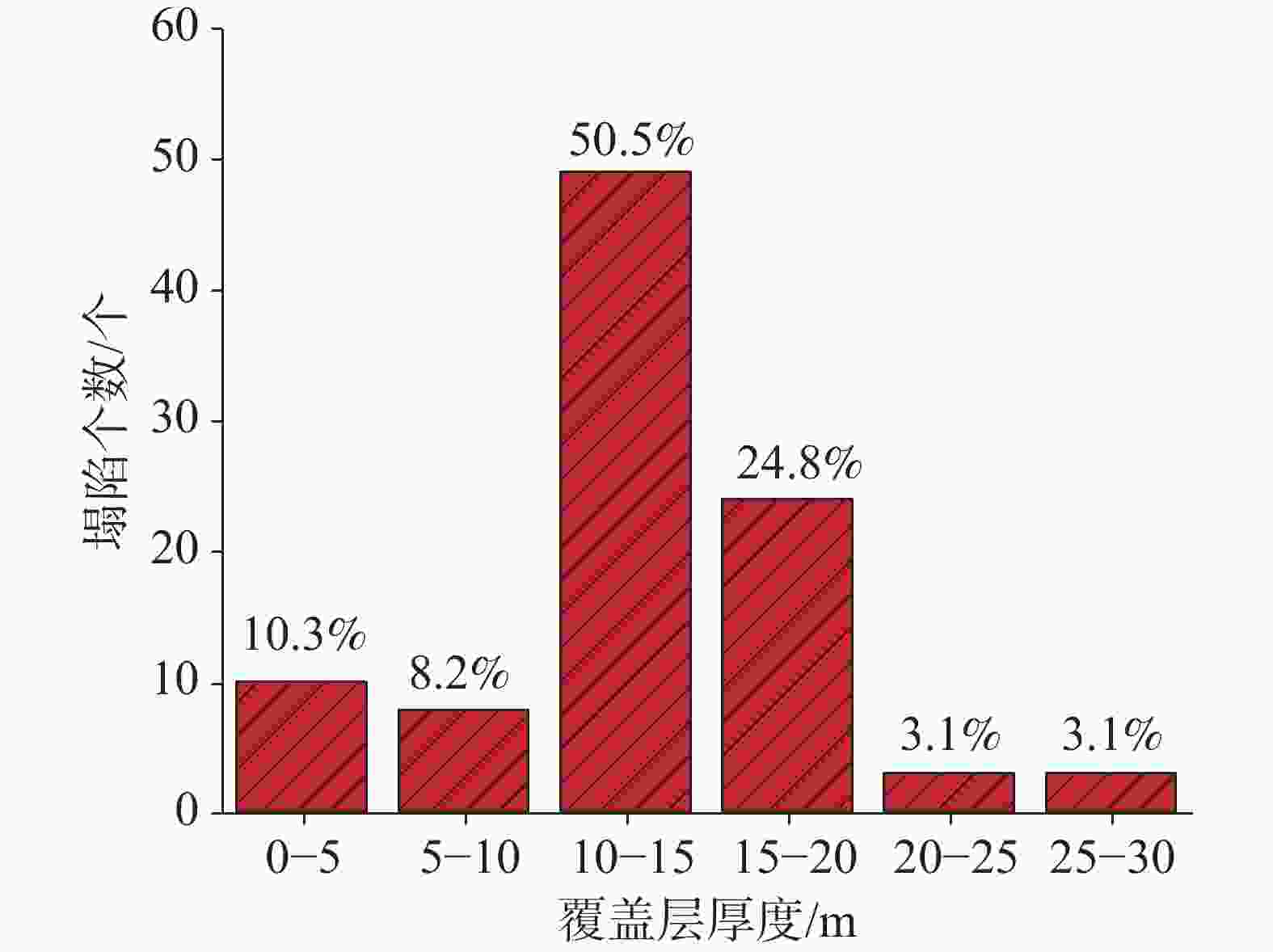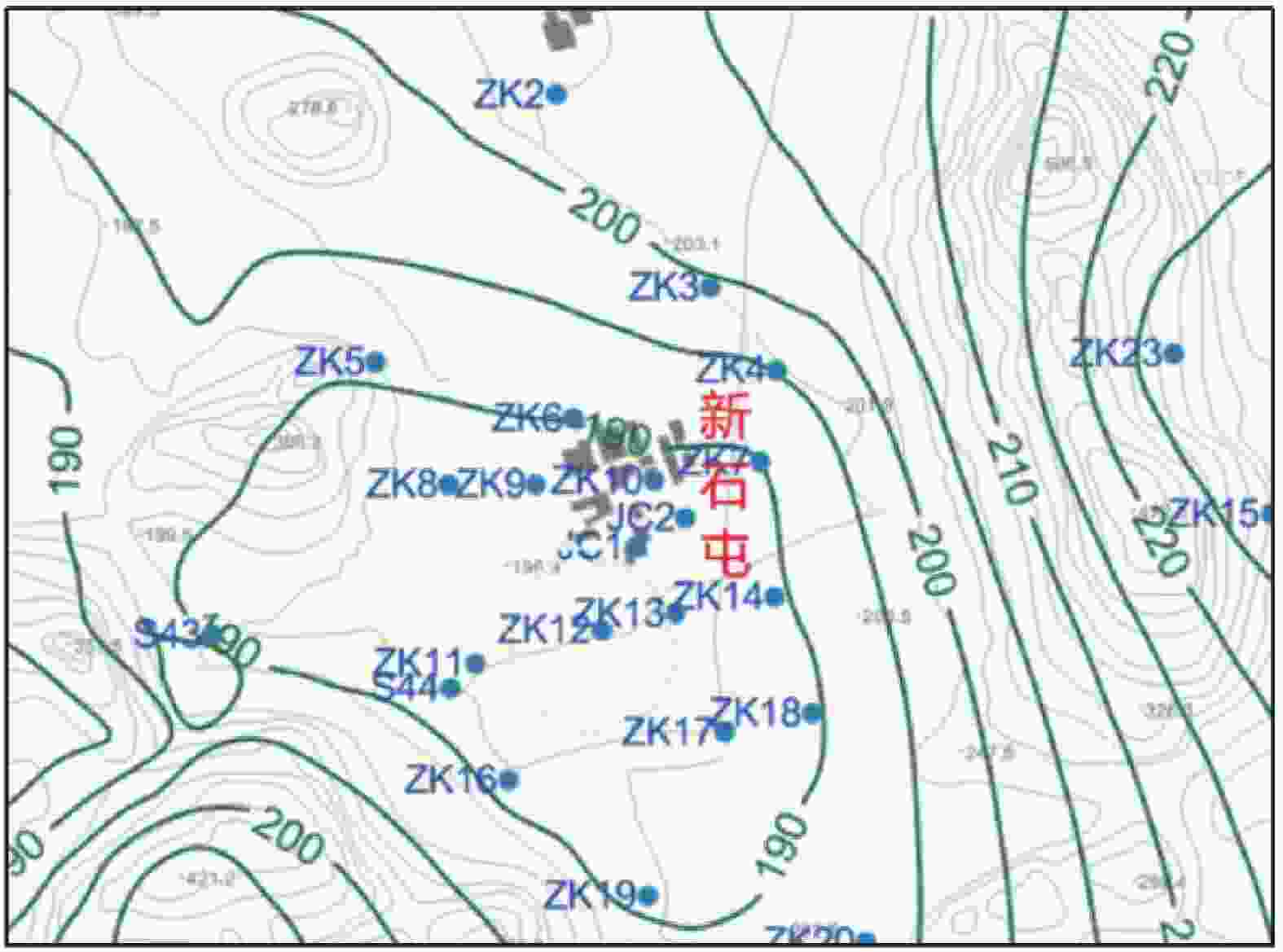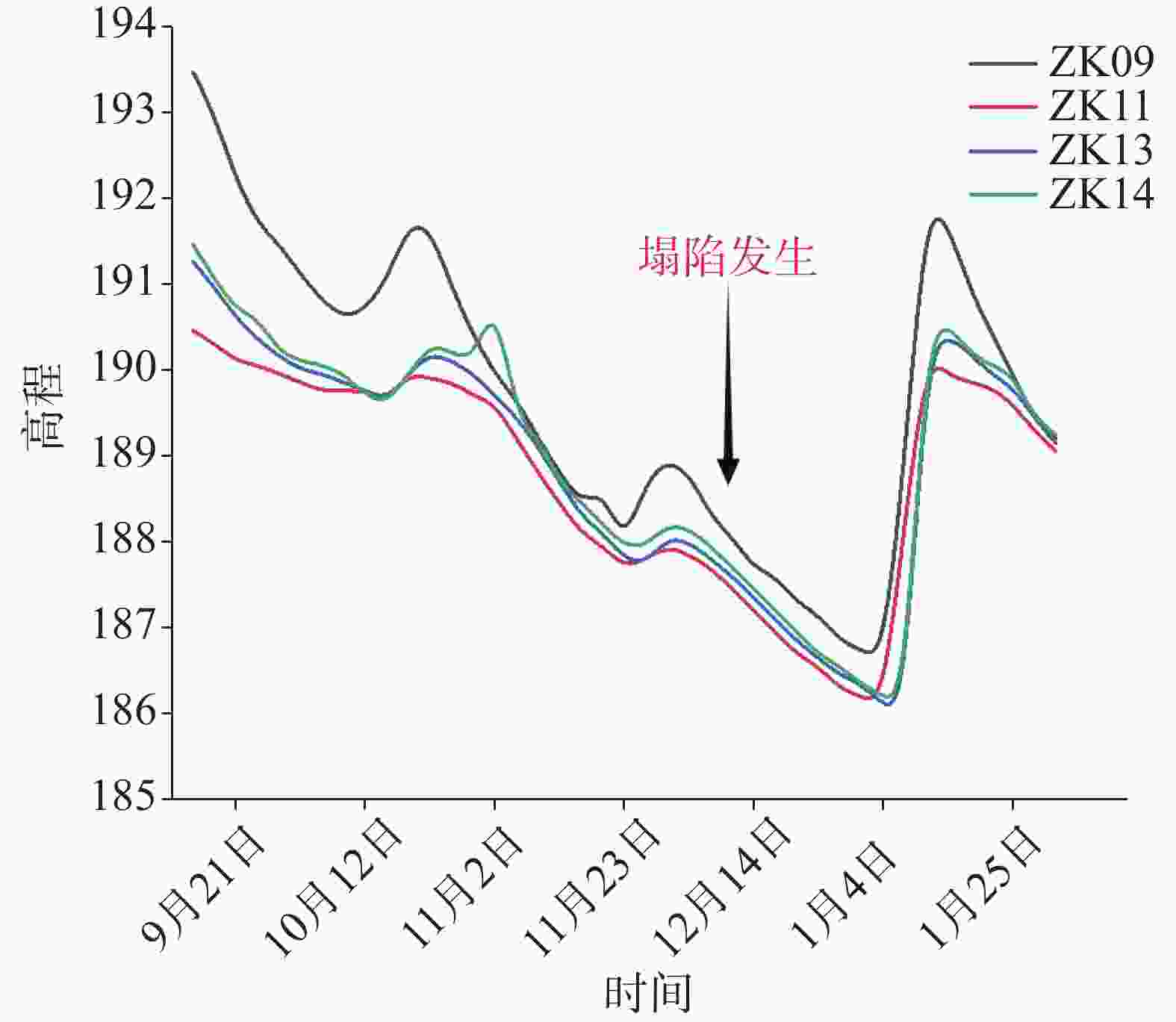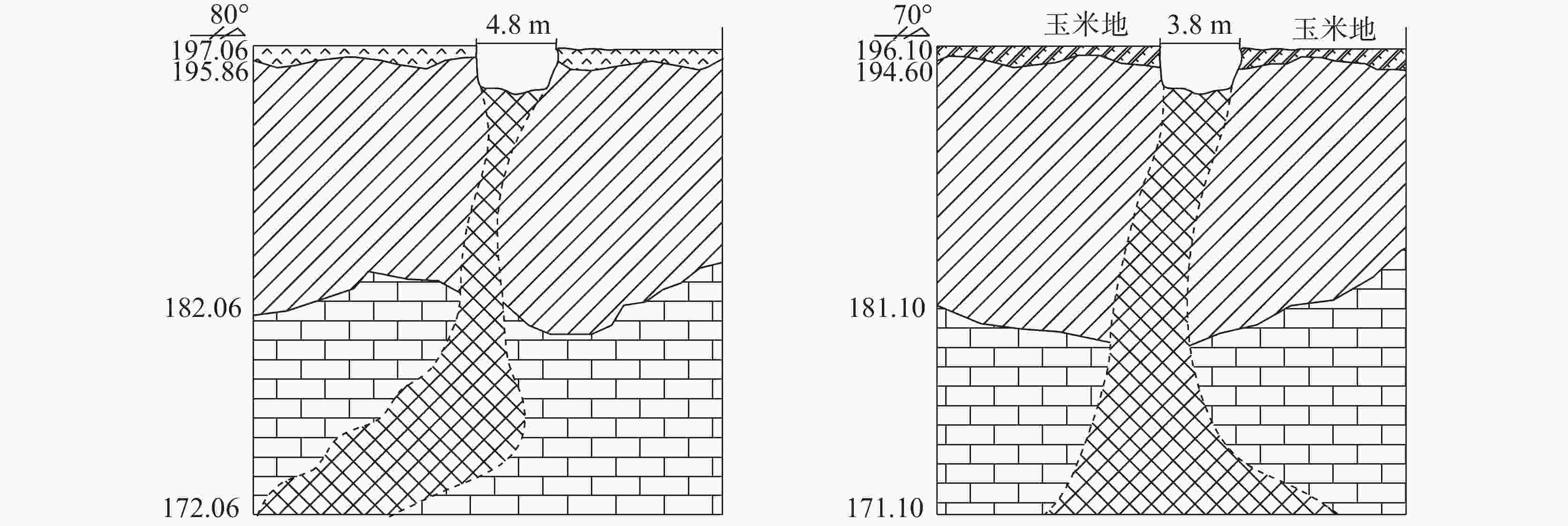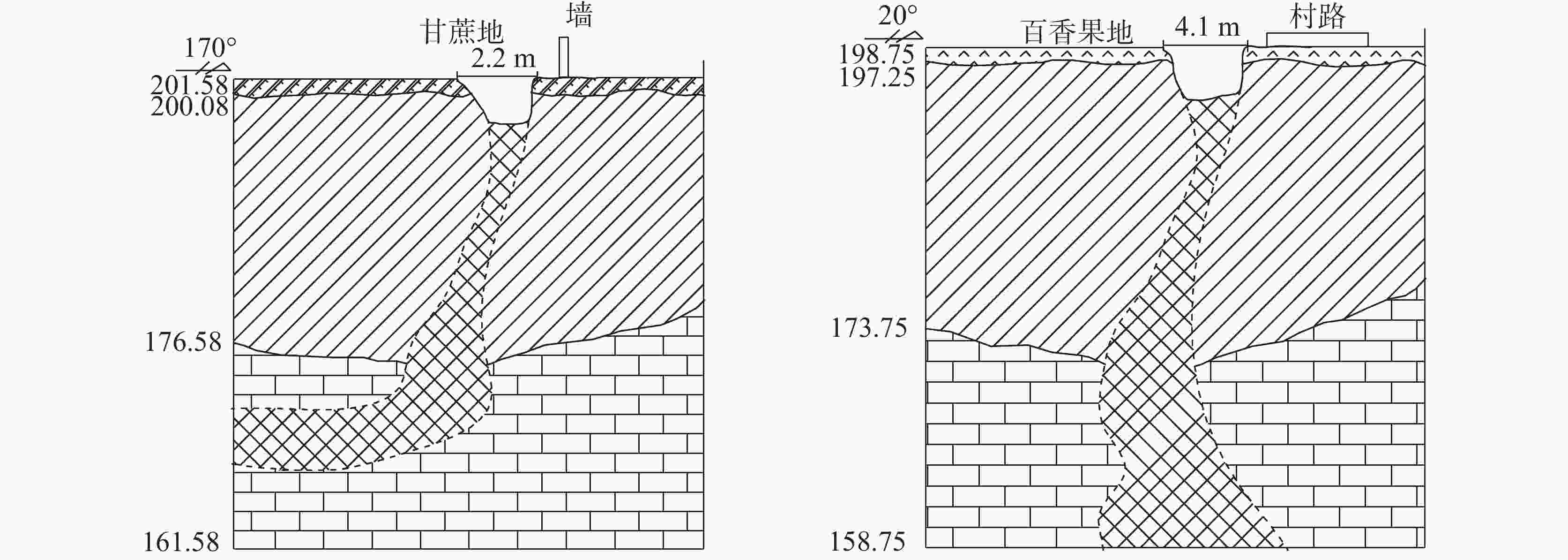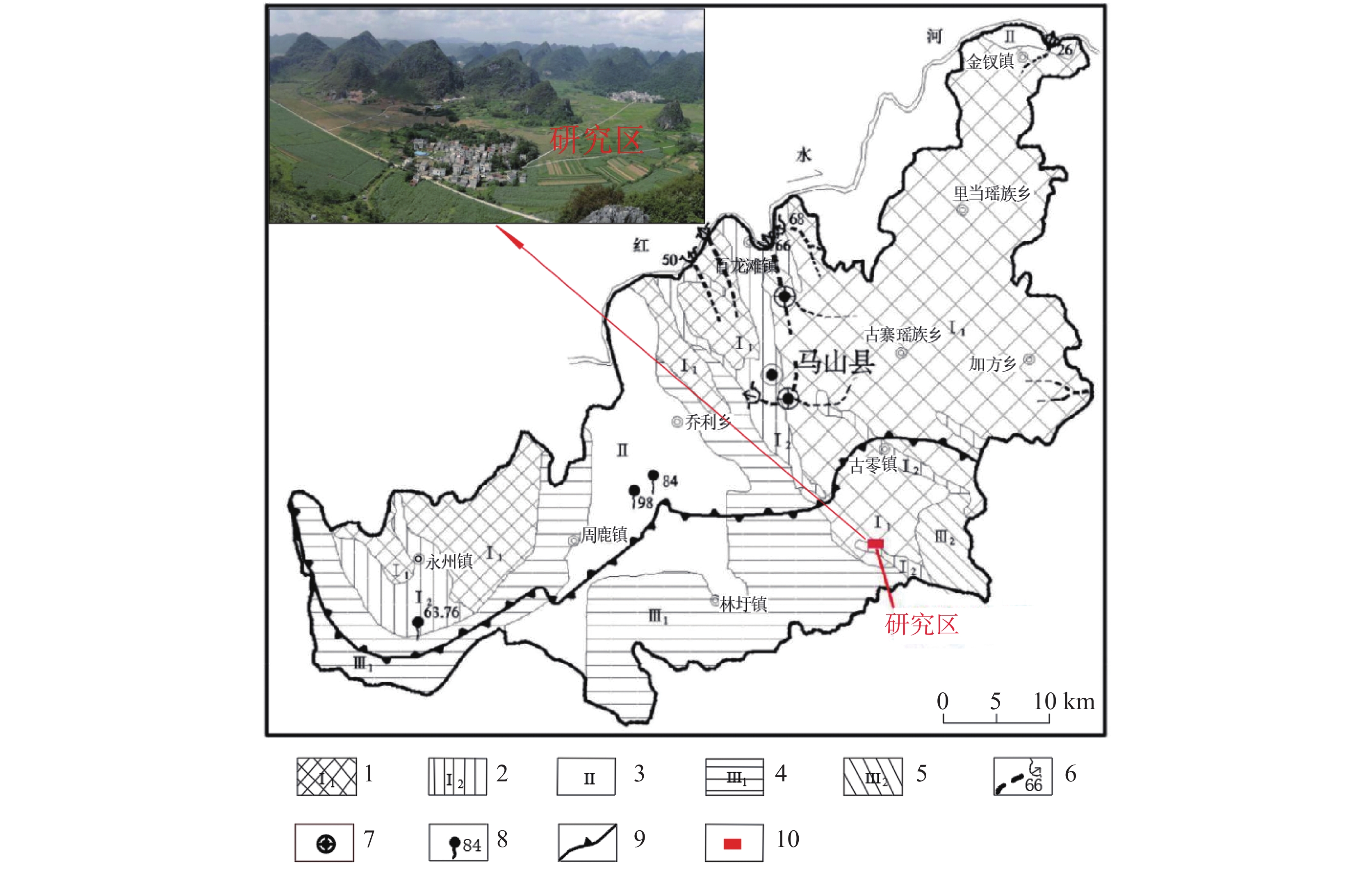Distribution law and formation mechanism of karst collapses in karst plains of Mashan county, Guangxi
-
摘要: 广西溶蚀平原区岩溶塌陷灾害频发、危害巨大,开展塌陷分布规律与形成机制研究是进行灾害预警与防控的基本前提。本文以广西马山县古零镇石丰村新石屯岩溶塌陷区为研究对象,通过对研究区地形地貌、地质构造、地层岩性以及气象条件等自然条件进行综合分析,同时结合物探和钻探等方法的验证,探讨了溶蚀平原区岩溶塌陷的分布规律、影响因素及成因机制,并深入研究了溶蚀平原区岩溶塌陷的成因机制。研究结果显示,岩溶地面塌陷主要集中于断层构造带岩溶强烈发育区域、覆盖层厚度中等地区以及地下水位剧烈波动区域。研究区岩溶塌陷的成因机制主要有真空吸蚀和潜蚀两种,其中约88%的岩溶塌陷是由真空吸蚀作用引起的,12%的岩溶塌陷由潜蚀作用引起的。研究结果为同类溶蚀平原地区岩溶地面塌陷预防和研究提供参考依据。Abstract:
Karst collapse disasters occur frequently and cause huge hazards in the karst dissolution plain of Guangxi. Research on the distribution law and formation mechanism of collapses is the basic premise for disaster early warning, prevention, and control. A total of 97 karst ground collapses have occurred in Xinshitun, Shifeng village, Guling town, Mashan county, Guangxi. The plane morphology of collapses is mostly approximately circular to elliptical, and the cross-sectional morphology is mostly funnel-shaped. The total area of collapse pits is 1,367 m2, with a maximum of 254 m2 and a minimum of 0.5 m2. Ground collapses have damaged buildings, restricted traffic, and severely threatened the safety of nearly 500 people’s lives and property, resulting in direct economic exceeding 10 million yuan. In this paper, the Xinshitun karst collapse in Shifeng Village is taken as the research object. Through a comprehensive analysis of the natural conditions, including topography, geological structure, stratigraphic lithology, and meteorological conditions in the study area, along with the verification of geophysical prospecting and drilling methods, this study discusses the distribution law, influencing factors, and genetic mechanisms of karst collapses in the dissolution plain. Furthermore, it delves deeply into the genetic mechanisms of karst collapses in this area. The distribution of collapses in this area indicates as follows,(1) Ground collapses are mainly distributed in areas with strong karst development in fault tectonic belts. Of these collapses, 46 occur 0–50 m away from the fault, representing 47.4%; 32 are located 50–100 m away from the fault, accounting for 33%; and 19 are situated more than 100 m away from the fault, comprising 19.6%. Notably, as the distance from the fault increases, the frequency of collapses decreases significantly. (2) Ground collapses are distributed in areas with moderate thickness of overburden layers. Most of these collapses are concentrated in the areas where the thicknesses of overburden layers range from 10 m to 20 m, totaling 73 incidents, accounting for 75.3% of the cases. In contrast, collapses occurring in overburden layers with thicknesses of 0–10 m and 20–30 m are less frequent, representing 18.5% and 6.2% of the total, respectively. (3) Ground collapses are distributed in the areas where there are significant fluctuations in groundwater levels. A rapid decline of groundwater level can cause the roof of a karst cave, which is originally supported by groundwater, to lose its supporting force, thus ultimately leading to a collapse. In general, the karst ground collapses in the study area are mainly influenced by three factors: geological structure, overburden thickness, and groundwater level. Specifically, these collapses are mainly distributed in areas with strong karst development within fault tectonic zones, areas with moderate overburden thickness, and areas where groundwater levels exhibit substantial fluctuations. Furthermore, the collapses occurring in the area where the three control factors jointly affect are more concentrated. In the study area, collapses are mainly caused by vacuum suction and suffoion. Most of these karst collapses, approximately 88% of the investigated collapse points, are caused by vacuum suction, while a small proportion, around 12%, is attributed to suffosion. The collapse zones created by vacuum suction erosion are mainly found in shallow overburden area characterized by poor permeability. Significant fluctuations in groundwater levels can lead to a drop in water levels below the bedrock, resulting in the loss of buoyancy within the cavities and the generation of negative pressure suction erosion within them. When combined with gravitational effects, this phenomenon may cause the overlying soil above the cavities to exceed the critical support threshold, ultimately resulting in karst collapses at the ground surface. The collapse zones formed by suffosion exhibit a high degree of karst development, development of karst caves, weak adhesion of overburden layers, substantial fluctuations in groundwater levels, and susceptibility of soil particles to erosion. When the roof of an upper soil layer reaches its critical stability, the upper soil becomes unstable, leading to instantaneous collapses. Both factors are the main mechanisms responsible for the formation of karst collapses in karst plains. This study examines the spatial relationship between collapses and fault tectonic belts, fluctuations in groundwater levels, and thicknesses of overburden layers to summarize the distribution laws and formation mechanisms of karst collapses in the Guangxi karst plains. The research findings provide a reference for the prevention and investigation of karst ground collapses in similar karst plain areas. -
Key words:
- karst collapse /
- distribution law /
- vacuum suction erosion /
- karst plain /
- fault effect
-
表 1 G1、G4测线解析结果
Table 1. Analytical results of lines G1 and G4
线号 异常点号 异常形态 推断解释结果 G1 376~385 “V”字型低阻异常 岩溶发育区,发育深度为11~14 m 518~538 “W”字型低阻异常 岩溶发育区,发育深度为27~33 m 668~701 “W”字型低阻异常 岩溶发育区,发育深度为36~69 m 768~788 “U”字型低阻异常 岩溶发育区,发育深度为35~54 m 850~880 “W”字型低阻异常 岩溶发育区,发育深度为35~59 m 940~990 “W”字型低阻异常 岩溶发育区,发育深度为7~36 m 1089~1115 低阻异常 岩溶发育区,发育深度为12~44 m G4 368~381 等值线不均匀 岩溶发育区,发育深度为15~23 m 508~541 中段等值线不均匀 岩溶发育区,发育深度为36~69 m 595~605 等值线不均匀 岩溶发育区,发育深度为11~14 m 613~621 等值线不均匀 岩溶发育区,发育深度为9~13 m 632~651 “V”字型低阻异常 岩溶发育区,发育深度为20~27 m 683~696 “V”字型低阻异常 岩溶发育区,发育深度为20~25 m 708~714 “V”字型低阻异常 岩溶发育区,发育深度为13~17 m 749~765 “V”字型低阻异常 岩溶发育区,发育深度为16~20 m -
[1] 雷明堂, 蒋小珍. 岩溶塌陷研究现状、发展趋势及其支撑技术方法[J]. 中国地质灾害与防治学报, 1998(3):1-6.LEI Mingtang, JIANG Xiaozhen. Research status, development trend and supporting technical methods of karst collapse[J]. The Chinese Journal of Geological Hazard and Control, 1998(3): 1-6. [2] 张丽芬, 曾夏生, 姚运生, 廖武林. 我国岩溶塌陷研究综述[J]. 中国地质灾害与防治学报, 2007(3):126-130. doi: 10.3969/j.issn.1003-8035.2007.03.027ZHANG Lifen, ZENG Xiasheng, YAO Yunsheng, LIAO Wulin. Summary of karst collapse research in China[J]. The Chinese Journal of Geological Hazard and Control, 2007(3): 126-130. doi: 10.3969/j.issn.1003-8035.2007.03.027 [3] 邓启江, 李星宇, 吕琼, 李坚峰. 昆明市岩溶塌陷发育特征和防治措施[J]. 中国岩溶, 2009, 28(1):23-29. doi: 10.3969/j.issn.1001-4810.2009.01.005DENG Qijiang, LI Xingyu, LYU Qiong, LI Jiaofeng. Development characteristics and prevention measures of karst collapse in Kunming City[J]. Carsologica Sinica, 2009, 28(1): 23-29. doi: 10.3969/j.issn.1001-4810.2009.01.005 [4] 金晓文, 陈植华, 曾斌, 张文慧, 史婷婷. 岩溶塌陷机理定量研究的初步思考[J]. 中国岩溶, 2013, 32(4):437-446.JIN Xiaowen, CHEN Zhihua, ZENG Bin, ZHANG Wunhui, SI Tingting. Preliminary thinking on quantitative study of karst collapse mechanism[J]. Carsologica Sinica, 2013, 32(4): 437-446. [5] 杨忠平, 高宇豪, 何科均, 卢丙清, 杨发祥. 基于易发性和降雨阈值的岩溶塌陷风险预测[J/OL]. 地下空间与工程学报, 1-12,2024-07-26.YANG Zhongping, GAO Yuhao, HE Kejun, LU Bingqing, YANG Faxiang. Risk prediction of karst collapse based on susceptibility and rainfall threshold[J/OL]. Chinese Journal of Underground Space and Engineering, 1-12[2024-07-26]. [6] 刘国文, 李涛, 徐鹏程, 王梦茜, 郑壹越, 胡望水, 齐东岩. 鄂尔多斯盆地大牛地西北部地区古岩溶形成机理[J]. 科学技术与工程, 2024, 24(15):6181-6189. doi: 10.12404/j.issn.1671-1815.2304777LIU Guowen, LI Tao, XU Pengcheng, WANG Mengxi, ZHENG Yiyue, HU Wangshui, QI Dongyan. Formation mechanism of paleokarst in northwestern Daniudi area, Ordos Basin[J]. Science Technology and Engineering, 2024, 24(15): 6181-6189. doi: 10.12404/j.issn.1671-1815.2304777 [7] 杨磊, 张耀磊, 宋光啸, 覃剑文, 潘光明. 覆盖型岩溶区地面塌陷灾变规律与影响因素研究[J/OL]. 应用基础与工程科学学报, 1-162024-07-26]. YANG Lei, ZHANG Yaolei, SONG Guangxiao, QIN Jianwen, PAN Guangming. Study on the disaster law and influencing factors of ground collapse in covered karst area[J/OL]. Journal of Basic Science and Engineering1-16[2024-07-26]. [8] 吴远斌, 罗伟权, 殷仁朝, 刘之葵, 戴建玲,潘宗源, 周富彪. 重庆市龙泉村:庆丰山村岩溶塌陷分布规律与成因机制[J]. 中国岩溶, 2021, 40(6):932-942.WU Yuanbin, LUO Weiquan, YIN Renchao, LIU Zhikui, DAI Jianling, PAN Zongyuan, ZHOU Fubiao. Distribution law and genetic mechanism of karst collapse in Longquan Village-Qingfengshan Village, Chongqing City[J]. Carsologica Sinica, 2021, 40(6): 932-942. [9] 张杰, 张生海. 栖霞中桥地区岩溶塌陷时空分布规律及成因分析[J]. 科学技术与工程, 2021, 21(1): 109-117.ZHANG Jie, ZHANG Shenghai. Temporal and spatial distribution and genesis analysis of karst collapse in Qixia Zhongqiao Area[j]. Science Technology and Engineering, 2021, 21(1): 109-117. [10] 江思义, 吴福, 刘庆超, 黄希明,李海良. 广西桂林市规划中心城区岩溶塌陷时空分布规律及成因分析[J]. 中国地质灾害与防治学报, 2020, 31(3):65-72.JIANG Siyi, WU Fu, LIU Qingchao, HUANG Ximing, LI Hailiang. Spatial-temporal distribution and causes of karst collapse in Guilin planning center, Guangxi Province[J]. The Chinese Journal of Geological Hazard and Control, 2020, 31(3): 65-72. [11] 高宗军, 王敏, 成世才, 钱丽丽. 岩溶地面塌陷的水-岩耦合模型[J]. 昆明理工大学学报(理工版), 2009, 34(3):6-11, 23.GAO Zongjun, WANG Min, CHENG Shicai, QIAN Lili. Water-rock coupling model of karst ground collapse[J]. Journal of Kunming University of Science and Technology, 2009, 34(3): 6-11, 23. [12] 高宗军. 岩溶地面塌陷形成机理与成因模式研究:以山东泰安—莱芜为例[J]. 中国工程科学, 2008(4):38-43. doi: 10.3969/j.issn.1009-1742.2008.04.005GAO Zongjun. Study on the formation mechanism and genetic model of karst ground collapse: Taking Tai 'an-Laiwu in Shandong Province as an example[J]. Strategic Study of Chinese Academy of Engineerng, 2008(4): 38-43. doi: 10.3969/j.issn.1009-1742.2008.04.005 [13] 周正, 李大华, 廖云平, 林军志, 张烨, 陈洪凯, 祁永爱, 王贺. 重庆中梁山岩溶地面塌陷特征及形成机理[J]. 中国岩溶, 2022, 41(1):67-78. doi: 10.11932/karst20220103ZHOU Zheng, LI Dahua, LIAO Yunping, LIN Junzhi, ZHANG Ye, CHEN Hongkai, QI Yonghai, WANG He. Characteristics and formation mechanism of karst ground collapse in Zhongliangshan, Chongqing[J]. Carsologica Sinica, 2022, 41(1): 67-78. doi: 10.11932/karst20220103 [14] 李前银. 再论岩溶塌陷的形成机制[J]. 中国地质灾害与防治学报, 2009, 20(3):52-55.LI Qianyin. Re-discussion on the formation mechanism of karst collapse[J]. The Chinese Journal of Geological Hazard and Control, 2009, 20(3): 52-55. [15] 徐卫国, 赵桂荣. 试论岩溶矿区地面塌陷的真空吸蚀作用[J]. 地质论评, 1981(2):174-180, 183. doi: 10.3321/j.issn:0371-5736.1981.02.013XU Weiguo, ZHAO Guirong. Discussion on vacuum suction erosion of ground collapse in karst mining area[J]. Geological Review, 1981(2): 174-180, 183. doi: 10.3321/j.issn:0371-5736.1981.02.013 [16] 徐卫国, 赵桂荣. 论岩溶塌陷形成机理[J]. 煤炭学报, 1986(2):1-11.XU weiguo, ZHAO guirong. On the formation mechanism of karst collapse[J]. Journal of Coal Science, 1986(2): 1-11. [17] 代群力. 岩溶矿区地面塌陷成因新说:共振论[J]. 中国煤田地质, 1991(3):66-68.DAI Qunli. A new theory on the genesis of ground collapse in karst mining area-resonance theory[J]. Coal Geology of China, 1991(3): 66-68. [18] 熊启华, 曾嘉, 王芮琼, 汪维芳, 李静, 杨琛, 陶良. 武汉长江Ⅰ级阶地覆盖型岩溶塌陷成因及力学模型研究[J]. 资源环境与工程, 2020, 34(3):408-412.XIONG Qihua, ZENG Jia, WANG Ruiqiong, WANG Weifang, LI Jing, YANG Chen, TAO Liang. Study on the causes and mechanical model of covered karst collapse in the first terrace of Yangtze River in Wuhan[J]. Resources Environment and Engineering, 2020, 34(3): 408-412. [19] 罗小杰, 罗程. 岩溶地面塌陷三机理理论及其应用[J]. 中国岩溶, 2021, 40(2):171-188.LUO Xiaojie, LUO Cheng. Three-mechanism theory of karst ground collapse and its application[J]. Carsologica Sinica, 2021, 40(2): 171-188. [20] 吴远斌, 刘之葵, 殷仁朝, 杨建兴, 罗伟权, 雷明堂, 戴建玲, 潘宗源. 湖南怀化盆地岩溶发育特征与分布规律[J]. 中国岩溶, 2022, 41(5):759-772, 807.WU yuanbin, LIU zhikui, YIN renchao, YANG Jianxing, LUO Weiquan, LEI Mingtang, DAI Jianling, PAN Zongyuan. Karst development characteristics and distribution law in Huaihua Basin, Hunan Province[J]. Carsologica Sinica, 2022, 41(5): 759-772, 807. [21] 万志博, 武雄, 徐晟, 李元仲, 杨蕊英, 陈鸿汉, 高明显, 张顺风. 枣庄市中区岩溶塌陷特征与成因分析[J]. 中国岩溶, 2006,25(2):146-151. doi: 10.3969/j.issn.1001-4810.2006.02.010WAN zhibo, WU xiong, XU sheng, LI Yuanzhong, YANG Ruiying, CHEN Honghan, GAO Mingxian, ZHANG Shunfeng. Analysis on characteristics and causes of karst collapse in central district of Zaozhuang City[J]. Carsologica Sinica, 2006,25(2): 146-151. doi: 10.3969/j.issn.1001-4810.2006.02.010 -




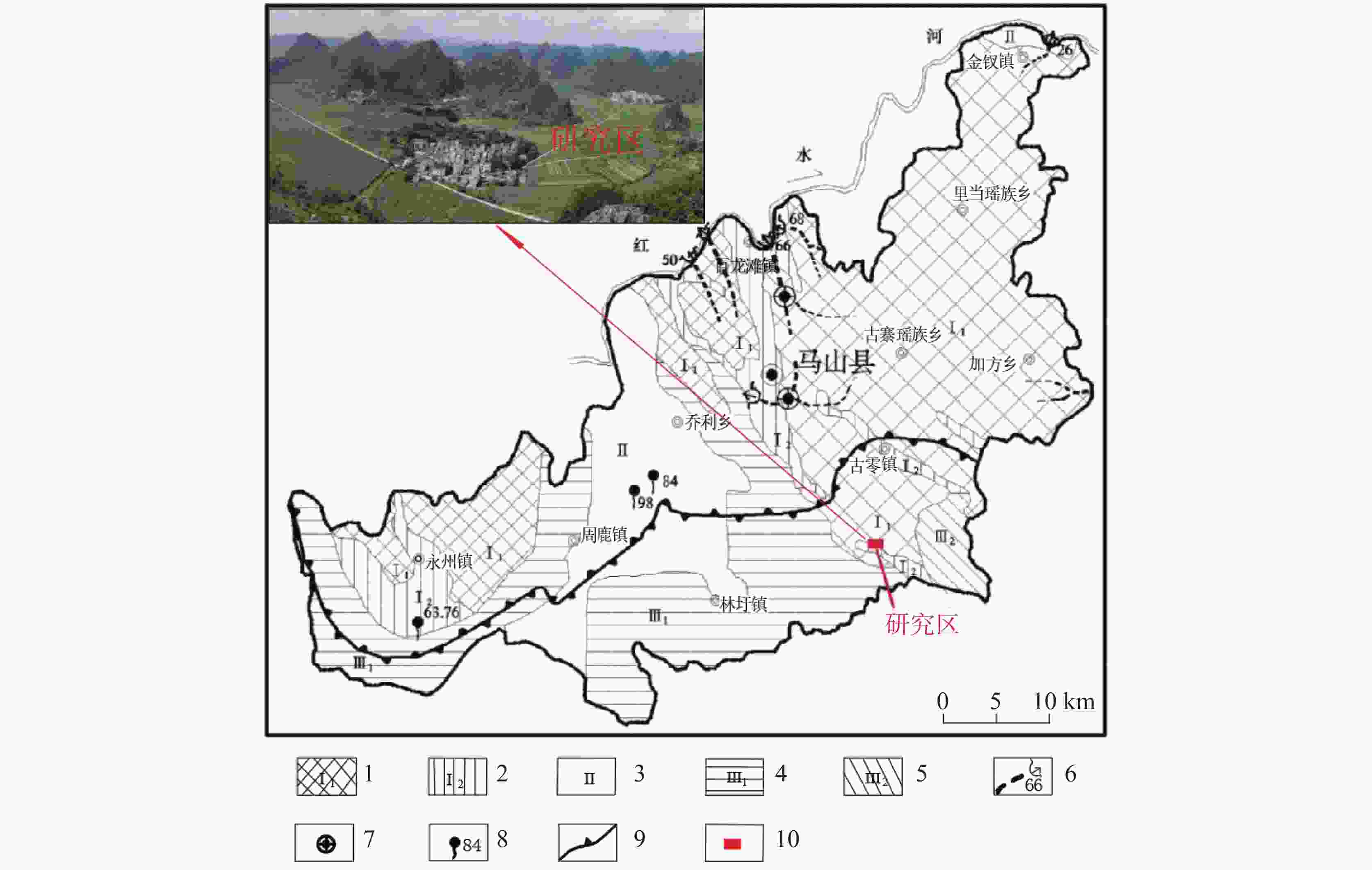
 下载:
下载:
